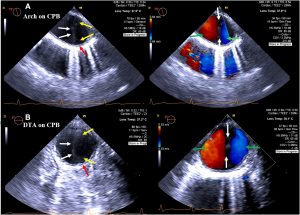 The latest issue of CASE is now available with intriguing reports, including “Multidirectional Blood Flow During Cardiopulmonary Bypass Mimicking an Iatrogenic Aortic Dissection During Transesophageal Echocardiographic Examination.” CASE Editor-in-Chief Vincent Sorrell, MD, FASE, remarked, “Foster et al. remind us all of one of the very important reasons this Journal has been such a success to our Society. These authors elegantly describe a common finding during cardiopulmonary bypass that may result in potentially devastating clinical consequences when not recognized. They performed a series of basic scientific steps to solve the root cause for understanding an image that initially appeared to be an aortic dissection. In doing so, they describe the pattern of multidirectional blood flow within the aorta that accompanies bypass cannulation. Next, they demonstrate the change in Doppler findings when the bypass flow is held. Lastly, they include post-operative tomographic imaging for further education. Readers unfamiliar with this finding may be spared an unnecessary poor outcome. Other readers may use this approach as a guide to their own CASE report when they are confronted with an echo/Doppler artifact.”
The latest issue of CASE is now available with intriguing reports, including “Multidirectional Blood Flow During Cardiopulmonary Bypass Mimicking an Iatrogenic Aortic Dissection During Transesophageal Echocardiographic Examination.” CASE Editor-in-Chief Vincent Sorrell, MD, FASE, remarked, “Foster et al. remind us all of one of the very important reasons this Journal has been such a success to our Society. These authors elegantly describe a common finding during cardiopulmonary bypass that may result in potentially devastating clinical consequences when not recognized. They performed a series of basic scientific steps to solve the root cause for understanding an image that initially appeared to be an aortic dissection. In doing so, they describe the pattern of multidirectional blood flow within the aorta that accompanies bypass cannulation. Next, they demonstrate the change in Doppler findings when the bypass flow is held. Lastly, they include post-operative tomographic imaging for further education. Readers unfamiliar with this finding may be spared an unnecessary poor outcome. Other readers may use this approach as a guide to their own CASE report when they are confronted with an echo/Doppler artifact.”
A second Intraoperative Echocardiography report follows the sequence of intraoperative clinical events that resulted in severe hypoxemia during aortic valve surgery, using TEE as a primary investigative tool. In the Congenital Heart Disease category, Fahim et al. expound upon their echo findings in an adult with a double-chambered right ventricle, including excellent correlative CMR images to enhance their echo insights. The next case highlights the critical value of peripheral ultrasound with a patient whose pseudoaneurysm found on vascular ultrasound uniquely had a second pseudoaneurysm evolving from the first. Just Another Day in the Echo Lab rounds out this issue with a reminder that serial TEE is crucial after placement of a left atrial appendage occlusion device.
Be sure to read Dr. Sorrell’s editorial as he shares insights from patients on how to better engage them in the echo process, so they can feel like informed, active participants in their progression of care.
Looking for a journal to submit your case report to? We want to hear from you!
Email us with questions or submit your report today.
